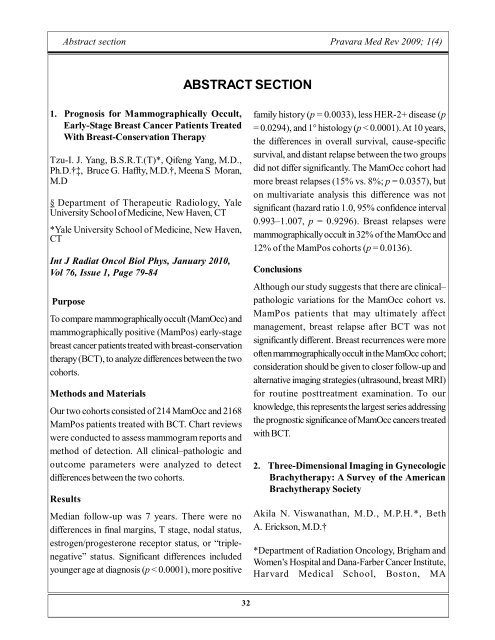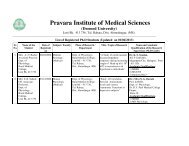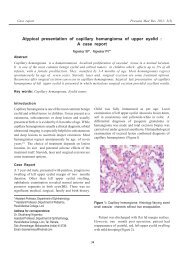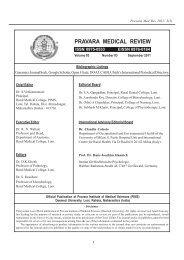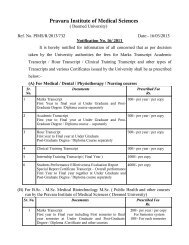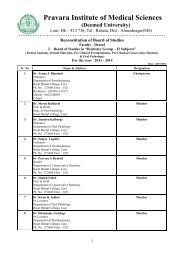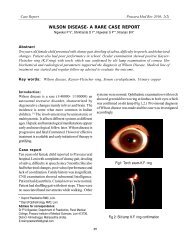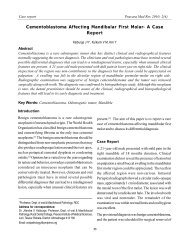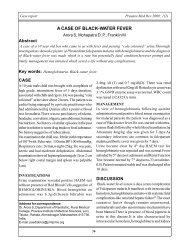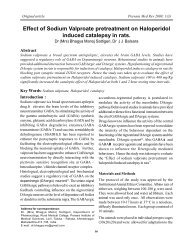ABSTRACT SECTION - Pravara Institute of Medical Sciences
ABSTRACT SECTION - Pravara Institute of Medical Sciences
ABSTRACT SECTION - Pravara Institute of Medical Sciences
Create successful ePaper yourself
Turn your PDF publications into a flip-book with our unique Google optimized e-Paper software.
Abstract section <strong>Pravara</strong> Med Rev 2009; 1(4)<br />
<strong>ABSTRACT</strong> <strong>SECTION</strong><br />
1. Prognosis for Mammographically Occult,<br />
Early-Stage Breast Cancer Patients Treated<br />
With Breast-Conservation Therapy<br />
Tzu-I. J. Yang, B.S.R.T.(T)*, Qifeng Yang, M.D.,<br />
Ph.D.†‡, Bruce G. Haffty, M.D.†, Meena S Moran,<br />
M.D<br />
§ Department <strong>of</strong> Therapeutic Radiology, Yale<br />
University School <strong>of</strong> Medicine, New Haven, CT<br />
*Yale University School <strong>of</strong> Medicine, New Haven,<br />
CT<br />
Int J Radiat Oncol Biol Phys, January 2010,<br />
Vol 76, Issue 1, Page 79-84<br />
Purpose<br />
To compare mammographically occult (MamOcc) and<br />
mammographically positive (MamPos) early-stage<br />
breast cancer patients treated with breast-conservation<br />
therapy (BCT), to analyze differences between the two<br />
cohorts.<br />
Methods and Materials<br />
Our two cohorts consisted <strong>of</strong> 214 MamOcc and 2168<br />
MamPos patients treated with BCT. Chart reviews<br />
were conducted to assess mammogram reports and<br />
method <strong>of</strong> detection. All clinical–pathologic and<br />
outcome parameters were analyzed to detect<br />
differences between the two cohorts.<br />
Results<br />
Median follow-up was 7 years. There were no<br />
differences in final margins, T stage, nodal status,<br />
estrogen/progesterone receptor status, or “triplenegative”<br />
status. Significant differences included<br />
younger age at diagnosis (p < 0.0001), more positive<br />
family history (p = 0.0033), less HER-2+ disease (p<br />
= 0.0294), and 1° histology (p < 0.0001). At 10 years,<br />
the differences in overall survival, cause-specific<br />
survival, and distant relapse between the two groups<br />
did not differ significantly. The MamOcc cohort had<br />
more breast relapses (15% vs. 8%; p = 0.0357), but<br />
on multivariate analysis this difference was not<br />
significant (hazard ratio 1.0, 95% confidence interval<br />
0.993–1.007, p = 0.9296). Breast relapses were<br />
mammographically occult in 32% <strong>of</strong> the MamOcc and<br />
12% <strong>of</strong> the MamPos cohorts (p = 0.0136).<br />
Conclusions<br />
Although our study suggests that there are clinical–<br />
pathologic variations for the MamOcc cohort vs.<br />
MamPos patients that may ultimately affect<br />
management, breast relapse after BCT was not<br />
significantly different. Breast recurrences were more<br />
<strong>of</strong>ten mammographically occult in the MamOcc cohort;<br />
consideration should be given to closer follow-up and<br />
alternative imaging strategies (ultrasound, breast MRI)<br />
for routine posttreatment examination. To our<br />
knowledge, this represents the largest series addressing<br />
the prognostic significance <strong>of</strong> MamOcc cancers treated<br />
with BCT.<br />
2. Three-Dimensional Imaging in Gynecologic<br />
Brachytherapy: A Survey <strong>of</strong> the American<br />
Brachytherapy Society<br />
Akila N. Viswanathan, M.D., M.P.H.*, Beth<br />
A. Erickson, M.D.†<br />
*Department <strong>of</strong> Radiation Oncology, Brigham and<br />
Women’s Hospital and Dana-Farber Cancer <strong>Institute</strong>,<br />
Harvard <strong>Medical</strong> School, Boston, MA<br />
32
Abstract section <strong>Pravara</strong> Med Rev 2009; 1(4)<br />
† Department <strong>of</strong> Radiation Oncology, <strong>Medical</strong> College<br />
<strong>of</strong> Wisconsin, Milwaukee, WI<br />
Int J Radiat Oncol Biol Phys, January 2010,<br />
Vol 76, Issue 1, Page 104-109<br />
Purpose<br />
To determine current practice patterns with regard to<br />
three-dimensional (3D) imaging for gynecologic<br />
brachytherapy among American Brachytherapy Society<br />
(ABS) members.<br />
Methods and Materials<br />
Registered physician members <strong>of</strong> the ABS received a<br />
19-item survey by e-mail in August 2007. This report<br />
excludes physicians not performing brachytherapy for<br />
cervical cancer.<br />
Results<br />
Of the 256 surveys sent, we report results for 133<br />
respondents who perform one or more implantations<br />
per year for locally advanced cervical cancer.<br />
Ultrasound aids 56% <strong>of</strong> physicians with applicator<br />
insertion. After insertion, 70% <strong>of</strong> physicians routinely<br />
obtain a computed tomography (CT) scan. The majority<br />
(55%) use CT rather than X-ray films (43%) or<br />
magnetic resonance imaging (MRI; 2%) for dose<br />
specification to the cervix. However, 76% prescribe<br />
to Point A alone instead <strong>of</strong> using a 3D-derived tumor<br />
volume (14%), both Point A and tumor volume (7%),<br />
or mg/h (3%). Those using 3D imaging routinely contour<br />
the bladder and rectum (94%), sigmoid (45%), small<br />
bowel (38%), and/or urethra (8%) and calculate<br />
normal tissue dose–volume histogram (DVH) analysis<br />
parameters including the D2cc (49%), D1cc (36%),<br />
D0.1cc (19%), and/or D5cc (19%). Respondents most<br />
commonly modify the treatment plan based on<br />
International Commission on Radiation Units bladder<br />
and/or rectal point dose values (53%) compared with<br />
DVH values (45%) or both (2%).<br />
Conclusions<br />
More ABS physician members use CT postimplantation<br />
imaging than plain films for visualizing the gynecologic<br />
brachytherapy apparatus. However, the majority<br />
prescribe to Point A rather than using 3D image based<br />
dosimetry. Use <strong>of</strong> 3D image–based treatment planning<br />
for gynecologic brachytherapy has the potential for<br />
significant growth in the United States.<br />
3. Lateral Decubitus Breast Boost: Description,<br />
Rationale, and Efficacy<br />
Michelle S. Ludwig, M.D., M.P.H.*, Marsha<br />
D. McNeese, M.D., Thomas A. Buchholz, M.D.,<br />
George H. Perkins, M.D., Eric A. Strom, M.D.<br />
*Department <strong>of</strong> Radiation Oncology, University <strong>of</strong><br />
Texas MD Anderson Cancer Center, Houston, TX<br />
Int J Radiat Oncol Biol Phys, January 2010, Vol<br />
76, Issue 1, Page 100-103<br />
Purpose<br />
To describe and evaluate the modified lateral decubitus<br />
boost, a breast irradiation technique. Patients are<br />
repositioned and resimulated for electron boost to<br />
minimize the necessary depth for the electron beam<br />
and optimize target volume coverage.<br />
Methods and Materials<br />
A total <strong>of</strong> 2,606 patients were treated with postlumpectomy<br />
radiation at our institution between January<br />
1, 2000, and February 1, 2008. Of these, 231 patients<br />
underwent resimulation in the lateral decubitus position<br />
with electron boost. Distance from skin to the maximal<br />
33
Abstract section <strong>Pravara</strong> Med Rev 2009; 1(4)<br />
depth <strong>of</strong> target volume was measured in both the<br />
original and boost plans. Age, body mass index (BMI),<br />
boost electron energy, and skin reaction were<br />
evaluated.<br />
Results<br />
Resimulation in the lateral decubitus position reduced<br />
the distance from skin to maximal target volume depth<br />
in all patients. Average depth reduction by repositioning<br />
was 2.12 cm, allowing for an average electron energy<br />
reduction <strong>of</strong> approximately 7 MeV. Mean skin entrance<br />
dose was reduced from about 90% to about 85% (p<br />
< 0.001). Only 14 patients (6%) experienced moist<br />
desquamation in the boost field at the end <strong>of</strong> treatment.<br />
Average BMI <strong>of</strong> these patients was 30.4 (range, 17.8–<br />
50.7). BMI greater than 30 was associated with more<br />
depth reduction by repositioning and increased risk <strong>of</strong><br />
moist desquamation.<br />
Conclusions<br />
The lateral decubitus position allows for a decrease in<br />
the distance from the skin to the target volume depth,<br />
improving electron coverage <strong>of</strong> the tumor bed while<br />
reducing skin entrance dose. This is a well-tolerated<br />
regimen for a patient population with a high BMI or<br />
deep tumor location.<br />
34


